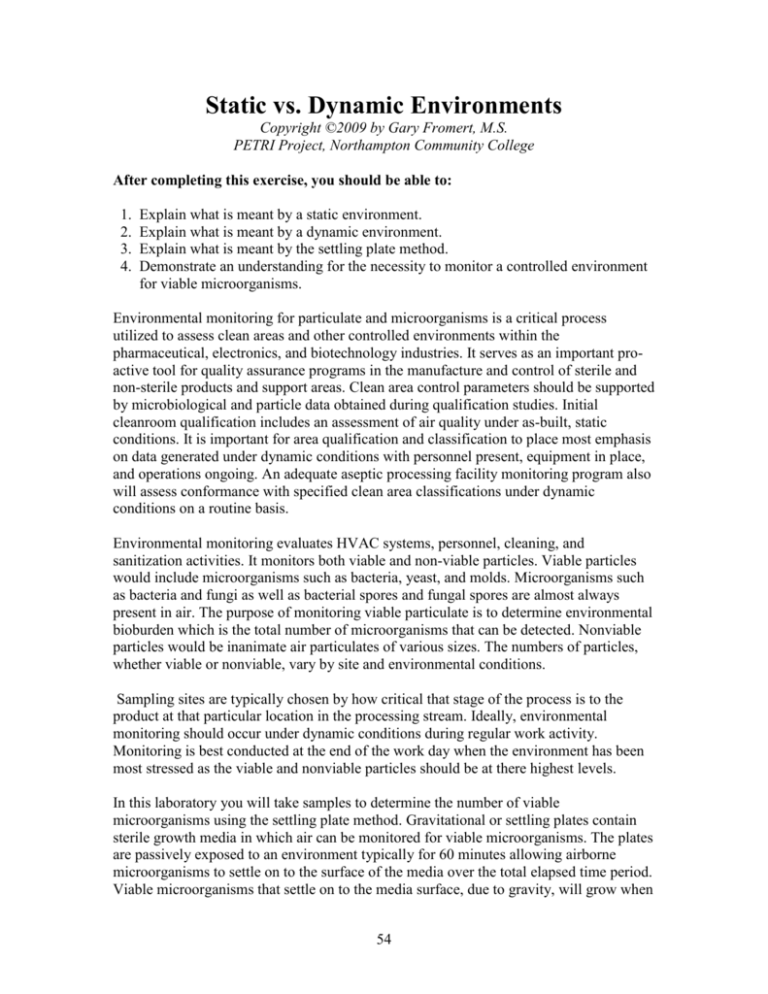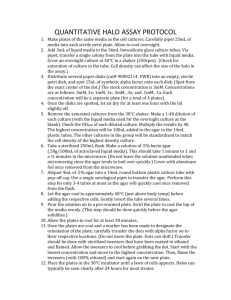Static vs Dynamic Environments
advertisement

Static vs. Dynamic Environments Copyright ©2009 by Gary Fromert, M.S. PETRI Project, Northampton Community College After completing this exercise, you should be able to: 1. 2. 3. 4. Explain what is meant by a static environment. Explain what is meant by a dynamic environment. Explain what is meant by the settling plate method. Demonstrate an understanding for the necessity to monitor a controlled environment for viable microorganisms. Environmental monitoring for particulate and microorganisms is a critical process utilized to assess clean areas and other controlled environments within the pharmaceutical, electronics, and biotechnology industries. It serves as an important proactive tool for quality assurance programs in the manufacture and control of sterile and non-sterile products and support areas. Clean area control parameters should be supported by microbiological and particle data obtained during qualification studies. Initial cleanroom qualification includes an assessment of air quality under as-built, static conditions. It is important for area qualification and classification to place most emphasis on data generated under dynamic conditions with personnel present, equipment in place, and operations ongoing. An adequate aseptic processing facility monitoring program also will assess conformance with specified clean area classifications under dynamic conditions on a routine basis. Environmental monitoring evaluates HVAC systems, personnel, cleaning, and sanitization activities. It monitors both viable and non-viable particles. Viable particles would include microorganisms such as bacteria, yeast, and molds. Microorganisms such as bacteria and fungi as well as bacterial spores and fungal spores are almost always present in air. The purpose of monitoring viable particulate is to determine environmental bioburden which is the total number of microorganisms that can be detected. Nonviable particles would be inanimate air particulates of various sizes. The numbers of particles, whether viable or nonviable, vary by site and environmental conditions. Sampling sites are typically chosen by how critical that stage of the process is to the product at that particular location in the processing stream. Ideally, environmental monitoring should occur under dynamic conditions during regular work activity. Monitoring is best conducted at the end of the work day when the environment has been most stressed as the viable and nonviable particles should be at there highest levels. In this laboratory you will take samples to determine the number of viable microorganisms using the settling plate method. Gravitational or settling plates contain sterile growth media in which air can be monitored for viable microorganisms. The plates are passively exposed to an environment typically for 60 minutes allowing airborne microorganisms to settle on to the surface of the media over the total elapsed time period. Viable microorganisms that settle on to the media surface, due to gravity, will grow when 54 the plates are incubated. Settling plates provide minimal interruption to the environment allowing them to be easily used in dynamic controlled environments as well as being used under static conditions. Sampling areas for this laboratory exercise will include both static and dynamic environments. Environmental monitoring will be accomplished by exposing sterile uncovered nutrient agar plates and Sabouraund's agar plates to the surrounding air for an extended period of time. After a specified exposure period and incubation period, the total number of microorganisms will be counted, recorded and the results from the two environments will be compared. Under these two different environmental conditions it should be expected to see different levels of microbial contamination. Materials (per student) 3 Nutrient Agar or Trypticase Soy Agar (TSA) Plates 3 Sabouraund's Agar Plates Timer China Marker or Sharpie Procedure 1 Environmental monitoring of a static and a dynamic environment Note: You will be instructed as to the rooms or locations that will be designated as static and dynamic environments. Settling Plate Method 1. Mark the bottom of one of the nutrient agar plates "Control", include your initials and the date, and then set aside. Do the same for one of the Sabouraud's agar plates. 2. Mark the bottom of one of the remaining nutrient agar plates "Static 60 min"; include your initials and the date. Do the same for one of the remaining Sabourand's agar plates. 3. Mark the bottom of the remaining nutrient agar plate "Dynamic 60 min"; include your initials and the date. Do the same for the remaining Sabourand's agar plate. 4. Expose one each of the nutrient agar plates and one each of the Sabourand's agar plates marked "Static 60 min" simultaneously to a static environment by removing the cover plate and placing it face down next to its respective plate. Allow the exposure time to elapse then cover each plate with its respective cover. 5. Expose one each of the nutrient agar plates and one each of the Sabourand's agar plates marked "Dynamic 60 min" simultaneously to a dynamic environment by removing the cover plate and placing it face down next to its respective plate. Allow the exposure time to elapse then cover each plate with its respective cover. 6. Incubate all three of the nutrient agar plates at 37°C for 24 to 48 hours. Incubate all three of the Sabourand's agar plates at room temperature for 3 to 5 days. 7. Observe all the plates for colonies of viable microorganisms that have grown on the respective media. Count the colonies and record. 55 Results and Observations After examining your plates, count the colonies and record your results in the following table. For all plates, quantify your results as follows: No growth 1 to 200 colonies > 200 colonies 0 Record the actual colony counts TNTC (Too numerous to count) Settling Plate Method Nutrient Plate (Total Count) Sabourand's Plate (Total Count) Control Static 60 min Dynamic 60 min Laboratory Review 1. Explain what is meant by static conditions in regard to a controlled environment. ________________________________________________________________________ ________________________________________________________________________ ________________________________________________________________________ ________________________________________________________________________ 2. Explain what is meant by dynamic conditions in regard to a controlled environment. ________________________________________________________________________ ________________________________________________________________________ ________________________________________________________________________ ________________________________________________________________________ 3. Explain what is meant by a settling plate and its usage. ________________________________________________________________________ ________________________________________________________________________ ________________________________________________________________________ ________________________________________________________________________ 4. What is the purpose of monitoring a controlled environment for viable microorganisms? ________________________________________________________________________ ________________________________________________________________________ ________________________________________________________________________ 5. Compare your results for the nutrient agar plates of the static environment and the dynamic environment and speculate as to difference in the number of colonies that grew. ________________________________________________________________________ ________________________________________________________________________ ________________________________________________________________________ 56







